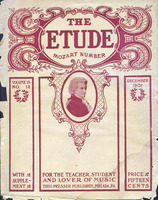In the November issue of The Etude the first two questions bearing on the subject “How do You Teach a Beginner?” were discussed for the benefit of all readers who are interested in teaching young and inexperienced players. Let us now resume and conclude this subject.
Introduction of Bowing.
In answer to my third question “How, and at what stage, do you introduce bowing?” my correspondent frankly informs me that my question is too vague. I freely admit that, put in this form, my question must seem vague to the majority of teachers; but this is owed entirely to the fact that nearly all teachers make the serious mistake of permitting the beginner to draw the bow. In other words, instead of guiding the pupil’s arm with the utmost care, the teacher permits him to make, unaided, the delicate experiment of employing the arm and producing tone. The immediate results are disastrous, the difficulties of achievement unnecessarily increased.
It will thus be seen that I meant, literally, what I said. A wide and varied experience in the teaching of beginners has served to convince me that if the teacher guides the arm and habituates it to its work, proper arm-development ceases to be so problematical a feature of violin-playing. The pupil should merely be taught to hold the bow correctly, the teacher assuming the responsibility of creating in the pupil’s arm and wrist that feeling which is essential to the production of a good tone.
Just how long a time the pupil should remain dependent upon the teacher for such guidance depends entirely upon circumstances and conditions. The decision of such a question calls for judgment and experience.
“Method.”
My fourth question was as follows: “Which ‘Method’ do you use, and what advantages does it seem to possess over other popular ‘Methods’?” To this my correspondent says:
“If, by ‘Method,’ you mean instruction-book, I don’t use any at all with beginners. I cull from various sources, writing much of the fundamental work to fit each pupil’s individual manner of development. All the ‘Methods’ I know presuppose too much development of the musical mind to be usable with young children of average capacity.”
My correspondent is quite right, in the main, though he might have expressed his meaning with greater clearness and accuracy. Nearly all instruction-books extant begin at the very beginning, but the order of their progress may briefly be said to be a succession of illogical leaps. It is advisable, nevertheless, to make use of some instruction-book just as soon as the pupil is reasonably familiar with the early difficulties of properly employing the fingers. Among the few books that succeed in being more or less logical in their progression, the “Method” by Wohlfahrt deserves mention and recommendation.
Recognition of Pitch.
The fifth question reads: “When, and how, do you begin systematically to train the pupil to recognize individual tones and differences in pitch?”
My correspondent answers: “If you refer to absolute pitch, I do not try at all. It is not necessary. If you refer to relative pitch, I begin with the first lesson in fingering, and the how of it is a matter of mental tone-placing.”
I alluded, of course, to relative pitch. Much can be accomplished, with the very beginner, in the matter of creating appreciation of pitch. I asked this question because too many teachers neglect this important feature of a pupil’s musical development. The average pupil is either indifferent to pitch and the individual character of the various tones, or too utterly absorbed in the endeavor to master technical difficulties to make any effort to remember the tones which he produces. It is therefore of the utmost importance that the teacher should devote some time, during every lesson, to the mental placing of tones.
Relaxation.
“How do you employ the frequent periods of rest made necessary by the physical strain of holding the instrument ?”
This was the last question asked, to which the following sensible answer was made: “I spend the periods of rest in relaxing both body and mind. I talk marbles and baseball, if nothing better suggests.”
Mozart and Shakespeare Compared.—Mozart is the brother of Shakespeare. As in literature Shakespeare stands solitary in his myriad-sideness, so also does Mozart in music. Nearly every other great man shows the limitations of his genius by the prevailing tone of his works. Shakespeare has no prevailing tone, but combine all excellences throughout his varied works, while none of them lends a general expression to his intellectual countenance. So with Mozart. He has the genial humor of Haydn, the intellectual power of Bach, the passionate beauty of Beethoven, with endless other excellences of his own. Every separate kind of fine work which is to be found in the sphere of music is to be found perfected in Mozart, the only expression which at all times is to be found upon his countenance is beauty. Therefore, as in Shakespeare’s case, his genius is admired in detached parts by those who appreciate what is beautiful, but rarely are its vast proportions justly measured.—J. Alfred Johnstone.



